Input interpretation

phenolphthalein
Chemical names and formulas
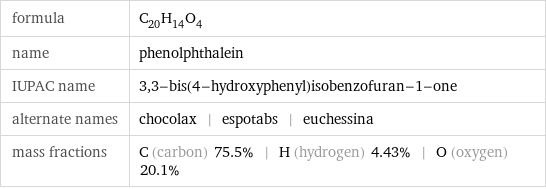
formula | C_20H_14O_4 name | phenolphthalein IUPAC name | 3, 3-bis(4-hydroxyphenyl)isobenzofuran-1-one alternate names | chocolax | espotabs | euchessina mass fractions | C (carbon) 75.5% | H (hydrogen) 4.43% | O (oxygen) 20.1%
Lewis structure
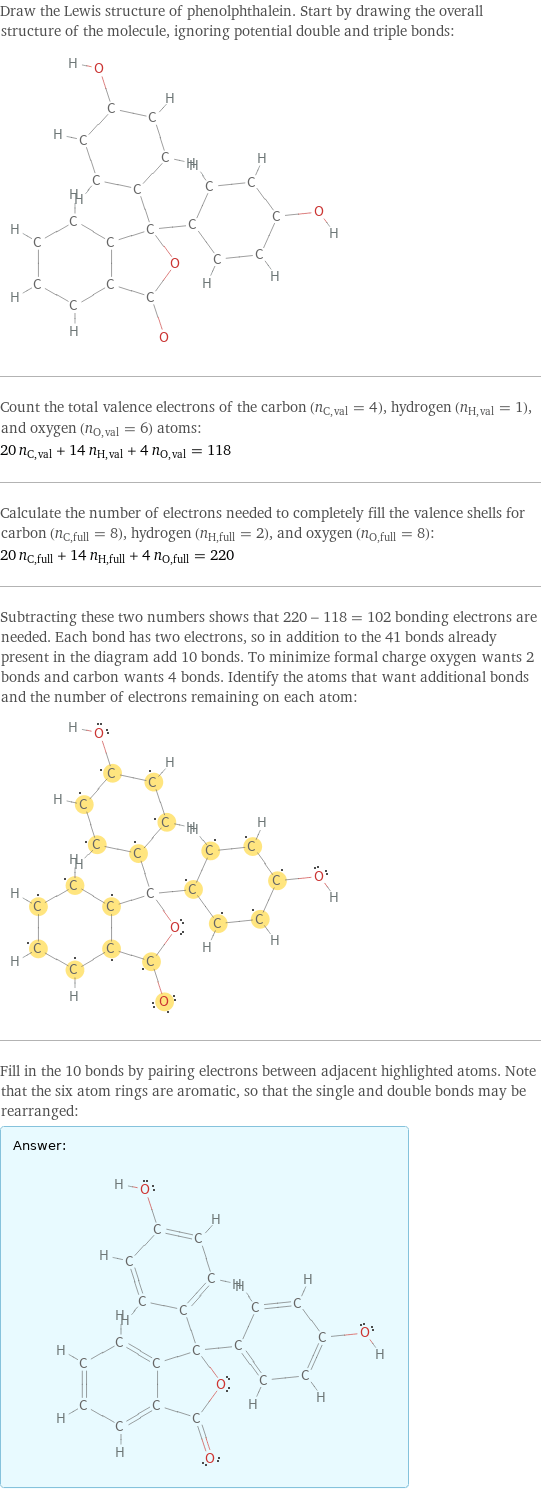
Draw the Lewis structure of phenolphthalein. Start by drawing the overall structure of the molecule, ignoring potential double and triple bonds: Count the total valence electrons of the carbon (n_C, val = 4), hydrogen (n_H, val = 1), and oxygen (n_O, val = 6) atoms: 20 n_C, val + 14 n_H, val + 4 n_O, val = 118 Calculate the number of electrons needed to completely fill the valence shells for carbon (n_C, full = 8), hydrogen (n_H, full = 2), and oxygen (n_O, full = 8): 20 n_C, full + 14 n_H, full + 4 n_O, full = 220 Subtracting these two numbers shows that 220 - 118 = 102 bonding electrons are needed. Each bond has two electrons, so in addition to the 41 bonds already present in the diagram add 10 bonds. To minimize formal charge oxygen wants 2 bonds and carbon wants 4 bonds. Identify the atoms that want additional bonds and the number of electrons remaining on each atom: Fill in the 10 bonds by pairing electrons between adjacent highlighted atoms. Note that the six atom rings are aromatic, so that the single and double bonds may be rearranged: Answer: | |
3D structure
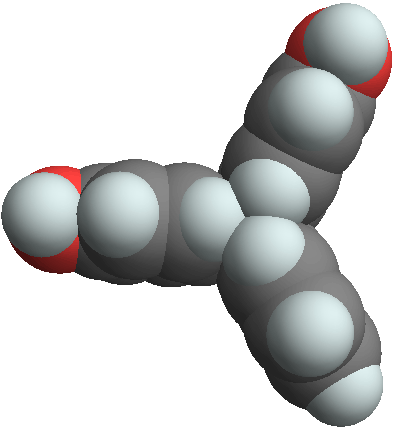
3D structure
Basic properties
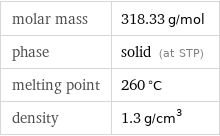
molar mass | 318.33 g/mol phase | solid (at STP) melting point | 260 °C density | 1.3 g/cm^3
Units

pH sensitivity

pH range | color change 8.2 to 10 | colorless to pink
Hydrophobicity and permeability properties

experimental LogP hydrophobicity | 2.41 predicted LogP hydrophobicity | 4.42 predicted LogS | -4.51
Basic drug properties

approval status | small molecule | withdrawn drug categories | indicators and reagent

brand names | agoral | alophen | chocolax | colax | correctol | doxan | doxidan | espotabs | euchessina | evac-q-kit | evac-q-kwik | evac-q-tabs | evac-u-gen | evac-v-lax | Ex-lax | feen-a-mint gum | feen-a-mint laxative mints | femilax | koprol | LILO | lax-pills | laxcaps | laxin | laxogen | medilax | modane | modane plus | phenolax | phillips gelcaps | phthalimetten | phthalin | prulet | purga | purgen | purgophen | spulmako-lax | trilax
Solid properties (at STP)

density | 1.3 g/cm^3 refractive index | 1.57
Units

Chemical identifiers
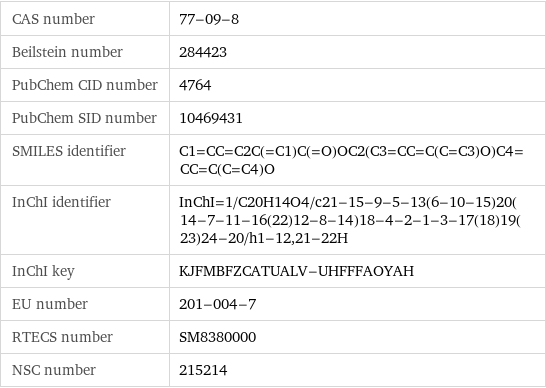
CAS number | 77-09-8 Beilstein number | 284423 PubChem CID number | 4764 PubChem SID number | 10469431 SMILES identifier | C1=CC=C2C(=C1)C(=O)OC2(C3=CC=C(C=C3)O)C4=CC=C(C=C4)O InChI identifier | InChI=1/C20H14O4/c21-15-9-5-13(6-10-15)20(14-7-11-16(22)12-8-14)18-4-2-1-3-17(18)19(23)24-20/h1-12, 21-22H InChI key | KJFMBFZCATUALV-UHFFFAOYAH EU number | 201-004-7 RTECS number | SM8380000 NSC number | 215214
NFPA label

NFPA label

NFPA health rating | 1 NFPA fire rating | 0 NFPA reactivity rating | 0
Toxicity properties

odor | odorless

RTECS classes | agricultural chemical and pesticide | tumorigen | mutagen | human data